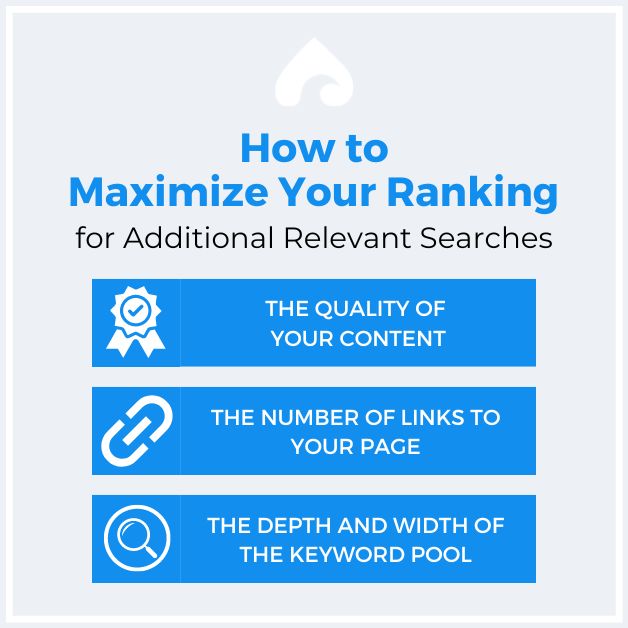You know what’s hard? Writing blog posts.
Multiple layers have to align to make blogging fruitful: from idea generation to outlining to writing to editing to publishing… the effort is real. And sometimes, after all that, there’s the disappointing reality that nobody is finding your carefully crafted, informative, valuable content.
Like many things in life, search engine algorithms are out of our control. But we can still exert influence over certain aspects of how well our content ranks based on observations about how the algorithms work. That influence is known as search engine optimization, or SEO.
One of the biggest components of optimizing content — maximizing your content’s chances of getting ranked — is to fully understand keywords.
What are keywords? How many keywords should you use? How do you use them? Knowing these SEO principles — and using them — will bump up your blog post rankings and make your content much easier to find.
What Is a Keyword? (And How Does It Work?)
Simply put, keywords are the words or turns-of-phrase your potential readers and customers type into the search engine of their choice (yeah, it’s Google). They’re the figurative keys to finding and unlocking access to your content.
For this to work, the blog writer has to understand where the searcher — the potential blog reader — is coming from. If, as a writer, you don’t understand how the searcher is thinking about what they’re looking for, you may use the right keyword, but you won’t necessarily create content the searcher wants.
There are an estimated 150 million active websites on the internet today, all competing for the searcher’s attention. That’s a pretty big haystack with your needle of content buried in it.
Google’s powerful algorithm searches that haystack on behalf of your potential reader. It looks for web pages containing the user’s search term (keyword) and assigns a rank to each page based on several factors, including how many times the keyword appears on the page. The higher the rank, the higher a page appears on Google’s search results pages (SERPs).
Usually, searchers don’t look beyond page one of the SERPs, which means if you want new eyes on your website, you need SEO in your toolbox.
How to Use Keywords for SEO
To make it as easy as possible for the readers you’re looking for (target readers) to find you, take their search terms (keywords) seriously. When you identify a relevant keyword you want to optimize for, dedicate your entire blog post to that topic. Answer everything a reader will want to know about the subject, and don’t deviate from it.
The algorithm’s job is to connect users with content that meets the needs of their search. To that end, it crawls your pages to find key words and phrases that tell Google what each one is about and whether it will meet searchers’ needs. And the algorithm is smart.
For example, even if a blog post is perfectly optimized for the keyword “what car should I buy,” Google won’t be interested in showing that web page to people searching for that term if it’s mostly about the history of cars.
One way to help Google connect your content with the people looking for it is to make it very clear what your target keyword is. Including your (relevant) keyword in a post’s introduction, conclusion, and about once every 100–200 words tells Google, “This is what my content is about!” Putting your keyword in a bold font is another great way to get the algorithm’s attention.
Don’t worry, this doesn’t mean there’s no creativity in feeding the almighty algorithm. I don’t find too much truth in the oft-repeated phrase “marketing kills creativity.” In fact, marketing hinges on creativity. You need some definite creative competence to work inconveniently phrased keywords into blog posts without killing the flow.
For example, below are a few ways to integrate the keyword “does red light therapy help acne” into a sentence:
- You might find yourself asking, “Does red light therapy help acne?” Read on to find the answer!
- As a skin care expert, I’m often asked, “Does red light therapy help acne?” I’m here to answer that question once and for all.
- So, does red light therapy help acne? Today, we’ll answer this oft-repeated question.
See what I mean? With a little brainstorming, you can maintain the flow of your post and wave a keyword under the algorithm’s nose.
How Many Keywords Should I Use for SEO?
I meet a lot of blog writers just getting to know SEO, and an assumption I hear often is, “The more keywords I include, the better optimized my post will be, right?” Well, not necessarily.
(To be clear, we’re talking here about how many different keywords you use in a post, not how many times you include the same keyword throughout a post.)
Most of the time, targeting one longer-tail keyword will suffice. Usually, that keyword is the most simple phrase your target reader will type into Google if they’re looking for information about your topic: “laser light therapy for dogs,” “does lack of sleep cause Alzheimer’s,” “how many keywords should I use,” for example. (See what I did there?)
If you integrate your keyword using the tips above, it should be all Google needs to drive traffic to your site.
You can use secondary and tertiary keywords as subheadings when you have a related keyword that doesn’t merit an entire post on its own. For example, let’s say you’re 100% positive your target reader will search “best hockey equipment brands,” but you don’t have enough information about the best hockey equipment brands to fill an entire 1,000-word blog post. You’re also pretty confident your target readers also search for “history of hockey equipment,” but you don’t need a whole post on the subject. So, you include a brief section about the history of hockey equipment in the post on hockey equipment brands.
Or, maybe you’re unsure whether your reader will search “best hockey equipment brands” or “best place to buy hockey equipment.” Why not use both? Making a secondary keyword out of another likely search term is a great way to make sure Google connects you with as many interested readers as possible.
FAQs or list posts tend to have more keywords. You might even use a separate keyword for every individual subheading in your listicle. Sometimes these rank well, sometimes not. We can’t control what the algorithm ranks; we just optimize, and let it do its thing.
How Many Keywords Can a Page Rank For?
Google’s complicated algorithm is, well, complicated. The truth is, even the most seasoned SEO pros are just scratching the surface of how all this truly works. A single page can rank for hundreds of relevant keywords. But how many exactly, and how can you use that to your advantage?
The minds behind the SEO software suite Ahrefs studied 3 million random search queries and found that the average #1 ranking page also ranked in the top 10 for nearly 1,000 other relevant keywords. This is great news for well-optimized content, but not so great for poorly optimized content. Lower-ranking pages tend to rank for fewer additional relevant keywords, according to Ahrefs.
Simply put, the better optimized your blog post is for one or two keywords, the better optimized it will be for other relevant keywords you’ve included without even knowing it! Just another example of the algorithm flexing its muscles.
How do you ensure Google will rank your blog post for these 1,000 other relevant searches? That depends on:
- The quality of your content
- The number of links to your page
- The depth and width of the keyword pool
A note on quality: As long as you’re optimizing well for one or two keywords, the main thing is to write great content. When the algorithm sees that searchers click through to your posts and stay there to read, it recognizes that you’ve produced quality content — and it wants to get quality content to more users.

How Do I Know Which Keyword to Pick?
If you’re early in your marketing campaign or if your site has a low domain rating (DR), longer-tail keywords with a low keyword difficulty (KD) are the way to go.
DR refers to the strength of your site’s backlinks, and KD estimates how hard it will be to rank for a given keyword on the first page of Google.
Even when your site becomes more established, it’s best not to get too ambitious. Keep targeting longer-tail keywords with lower KD rather than shooting for high KD, shorter-tail keywords. Shorter-tail keywords are much less targeted anyway, since you can’t be sure what the searchers are really looking for.
Still Overwhelmed?
Still struggling to optimize your content and bring new eyes to your site? Don’t want to waste time and marketing dollars on trial and error? I don’t blame you. Thankfully, you don’t have to go at it alone.
If you’d like some help figuring out how many keywords to use or how they fit into your content strategy, you don’t have to look far. Fluxe produces high-quality, well-optimized content every month for businesses like yours, and we’re proud of the results. If you’d like to see what we can do for you, drop us a line. We’d love to help.



